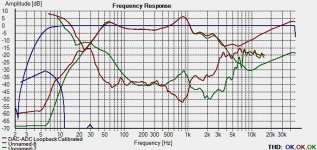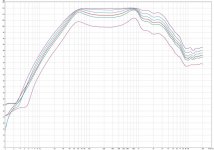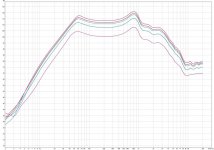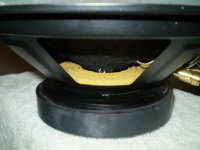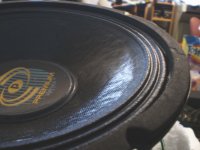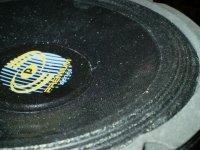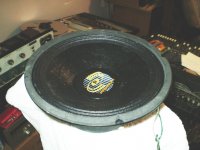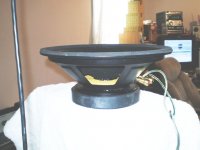Yeah, I don't think I really need the bottom end too much.
I was thinking $600-700 for speakers, cabinets, and hardware. Amps are separate.
You think I should go the biamping route? I've never used a biamped PA before. If I xover at a pretty low freq, doesn't that mean more power is going to the horns? If I biamp does that mean I need probably three way cabs? I am open to this for sure though. When biamping, do I use separate cabs for the high and low, or just two inputs into the same cab?
What is your recommendation? I would like to try and stick with the PA head that my friend has for now, but perhaps I could try the biamping route.
There is usually no stage, or a short one (2-3 feet high perhaps)
If you think I can build quality PA cabs for less too, I'm certainly willing to go that route.
I was thinking $600-700 for speakers, cabinets, and hardware. Amps are separate.
You think I should go the biamping route? I've never used a biamped PA before. If I xover at a pretty low freq, doesn't that mean more power is going to the horns? If I biamp does that mean I need probably three way cabs? I am open to this for sure though. When biamping, do I use separate cabs for the high and low, or just two inputs into the same cab?
What is your recommendation? I would like to try and stick with the PA head that my friend has for now, but perhaps I could try the biamping route.
There is usually no stage, or a short one (2-3 feet high perhaps)
If you think I can build quality PA cabs for less too, I'm certainly willing to go that route.
$300-350 per box is a far better budget range to get something respectable going.
Bi-amping has nothing to do with whether you need 2 or 3 way cabs, and has nothing to do with whether you build your cabs as multiples or singles. Those are all design decisions that are mostly separate of how you amplify and cross over the system.
You'll have to forgive me this term "PA head" just doesn't ring as a common terminology in my scope of this stuff. I believe that what you mean by "PA head" is a combination mixer and amplifier (the pro sound world equivalent of an integrated amp). If you're going to use such a device, then bi-amping may be a bit more complicated to integrate, however, there may be a way to use the powered mixer for the high frequency and a separate stereo power amp for the low frequency. I would need to see specifics on the head you are using to tell you if this is realistic or not. Is it something like this? Peavey PVi 8B 8-Channel Powered Mixer 150W 248-8356
The "normalish" approach is to use a mixer board (no built in amplification), then run the line level mixed output to an active crossover, then from there, with signal levels split, to separate channels of power amps to then power the intended speakers. The active crossover is often found integrated into a power amplifier, so there is no need for this as a separate component for less demanding applications. If you intend to mix a "stereo" signal with levels adjusted per channel for different performers (depending on stage position etc), then you will need 2 channels of amplification for each bi-amped speaker (4 channels total for a stereo pair, bi-amped). If you intend to mix everything down to mono, then you can get by with just 2 channels of amplification for the complete system.
I think the primary reason that at least bi, sometimes tri/quad-amping is so crucial for live sound reinforcement, is that, a low pass passive filter for the woofers will always require at least one, if not multiple inductors in series in order to create the low pass filter. When you start looking at the SIZE and COST of the inductors required to handle the current involved, you realize it's not worth the design headache, losses, and distortion that they might introduce. You can easily end up spending $100-200 on inductors alone to build a pair of passively crossed over PA cabs (not to mention, probably another $50 in caps). That's about half way to the cost of another great power amp. For higher frequency cross-overs (like the upper x-over/s in a 3 or 4 or more way system), passive is much more cost effective.
The reason I asked about stage height, is you should factor in the cost of some stands to get the speakers up in the air if you will be performing near ground level. You don't want the system blasting a few people in the front row and being absorbed and dissipated in their organs. Get the speakers up in the air and positioned such that the vertical dispersion of the design will be "aimed" just such that roughly the bottom of it's vertical dispersion is "hitting" the listening position in the front row. The rest should be aimed out and over the top of the crowd. By combining speaker designs with respectably wide dispersion characteristics, with careful placement, you can provide a decent performance for both the front and rear rows, albeit, with diminishing listening levels but still good sounding towards the rear.
Eric
Bi-amping has nothing to do with whether you need 2 or 3 way cabs, and has nothing to do with whether you build your cabs as multiples or singles. Those are all design decisions that are mostly separate of how you amplify and cross over the system.
You'll have to forgive me this term "PA head" just doesn't ring as a common terminology in my scope of this stuff. I believe that what you mean by "PA head" is a combination mixer and amplifier (the pro sound world equivalent of an integrated amp). If you're going to use such a device, then bi-amping may be a bit more complicated to integrate, however, there may be a way to use the powered mixer for the high frequency and a separate stereo power amp for the low frequency. I would need to see specifics on the head you are using to tell you if this is realistic or not. Is it something like this? Peavey PVi 8B 8-Channel Powered Mixer 150W 248-8356
The "normalish" approach is to use a mixer board (no built in amplification), then run the line level mixed output to an active crossover, then from there, with signal levels split, to separate channels of power amps to then power the intended speakers. The active crossover is often found integrated into a power amplifier, so there is no need for this as a separate component for less demanding applications. If you intend to mix a "stereo" signal with levels adjusted per channel for different performers (depending on stage position etc), then you will need 2 channels of amplification for each bi-amped speaker (4 channels total for a stereo pair, bi-amped). If you intend to mix everything down to mono, then you can get by with just 2 channels of amplification for the complete system.
I think the primary reason that at least bi, sometimes tri/quad-amping is so crucial for live sound reinforcement, is that, a low pass passive filter for the woofers will always require at least one, if not multiple inductors in series in order to create the low pass filter. When you start looking at the SIZE and COST of the inductors required to handle the current involved, you realize it's not worth the design headache, losses, and distortion that they might introduce. You can easily end up spending $100-200 on inductors alone to build a pair of passively crossed over PA cabs (not to mention, probably another $50 in caps). That's about half way to the cost of another great power amp. For higher frequency cross-overs (like the upper x-over/s in a 3 or 4 or more way system), passive is much more cost effective.
The reason I asked about stage height, is you should factor in the cost of some stands to get the speakers up in the air if you will be performing near ground level. You don't want the system blasting a few people in the front row and being absorbed and dissipated in their organs. Get the speakers up in the air and positioned such that the vertical dispersion of the design will be "aimed" just such that roughly the bottom of it's vertical dispersion is "hitting" the listening position in the front row. The rest should be aimed out and over the top of the crowd. By combining speaker designs with respectably wide dispersion characteristics, with careful placement, you can provide a decent performance for both the front and rear rows, albeit, with diminishing listening levels but still good sounding towards the rear.
Eric
Last edited:
I have done lot's of metalbands. Any genre from italian tech metal to Danish viking metal.
What you need to inform is the size of the typical venue. Is it 200 sqm or is it 500?
Anyway, 2x18" is to prefer, but real 15" PA woofer can do the trick as well. Many venues are not suited for live music because they are undamped, and any freq. below 80 Hz is a pain, and even if the venue is acustically treated you dont really need anything lower than 60 Hz. The typical dubble bas of the genre wil have lot's of klick and not very much lows. I have just seen two Fane 18" colossus for 120$/pair. Go for a bargain like that. The the top I would recommend 12" + 1" horn (B&C is very good for the price, and have som very nice coax 12"). Again it's better to go used, and find a well known brand than buy som new stuff that sound awfull (especially the tweeter).
Active crossover come very cheap, and so does amps. So don't even bother to think passive. Again I would strongly recommend used amps. Crown, Ecler, Yamaha, Peavy and a lot of other known brands. You can also build from ready made class d modules, but it will be same price as good used gear.
For the vocals it's essential to have a good mic (just a plain old Shure SM58) and a good preamp with tubecomp (or tube like - cheap Behringer comp's sounds awfull, so use a little extra). I know lots of vocalist don't see the mic/comp te be part of their budget, but look at what the other guys in a band spend on their gear.
For guitars I will reccomend a mix of traditional mic'ed cabs and lineout. Here Behringer is fine with this one BEHRINGER: GI100
For the bass drums, A Shure SM57 very close to where the pedals meet drum to get click and another one further out to have natural lows.
What you need to inform is the size of the typical venue. Is it 200 sqm or is it 500?
Anyway, 2x18" is to prefer, but real 15" PA woofer can do the trick as well. Many venues are not suited for live music because they are undamped, and any freq. below 80 Hz is a pain, and even if the venue is acustically treated you dont really need anything lower than 60 Hz. The typical dubble bas of the genre wil have lot's of klick and not very much lows. I have just seen two Fane 18" colossus for 120$/pair. Go for a bargain like that. The the top I would recommend 12" + 1" horn (B&C is very good for the price, and have som very nice coax 12"). Again it's better to go used, and find a well known brand than buy som new stuff that sound awfull (especially the tweeter).
Active crossover come very cheap, and so does amps. So don't even bother to think passive. Again I would strongly recommend used amps. Crown, Ecler, Yamaha, Peavy and a lot of other known brands. You can also build from ready made class d modules, but it will be same price as good used gear.
For the vocals it's essential to have a good mic (just a plain old Shure SM58) and a good preamp with tubecomp (or tube like - cheap Behringer comp's sounds awfull, so use a little extra). I know lots of vocalist don't see the mic/comp te be part of their budget, but look at what the other guys in a band spend on their gear.
For guitars I will reccomend a mix of traditional mic'ed cabs and lineout. Here Behringer is fine with this one BEHRINGER: GI100
For the bass drums, A Shure SM57 very close to where the pedals meet drum to get click and another one further out to have natural lows.
So I have tossed around some numbers in my head for a bit, and think that based on the budget, assuming you are set on building from new drivers (don't discount Kjeldsen and other's suggestion to just go hunting for some quality used gear) I would use Dayton Pro drivers in one of the following configurations.
2x15" per cab, +horn ~$210 in drivers.
3x12" per cab, +horn ~$260 in drivers.
4x10" per cab, + horn ~$240 in drivers.
3-5ft^3 box size for any of these configurations will work. Vents should have around 100sq inch cross section and a few inches length to tune in the 60-80hz range. (On the 10" and 12" configurations, a long skinny slot port running the height of the cab next to the drivers, on the 2x15" configurations, a slot port below the drivers at the bottom of the cab, we can discuss and compare specific tuning and volume if you decide to pick one of these configurations)
Horn driver would be the D220Ti or PSD:2002. ($50-60 range) Which horn to mate them to will depend on what woofers you decide to run but there are several around $10 that will work. (these prices have been factored into the above driver cost estimates)
That leaves around $90-140 to finish out the cabs... That could be a bit tight. You'll need roughly a 4x8 sheet per box (use the 3/4" birch from lowes, specific dimensions can be discussed later, lots of options here). That's $45 per cab. Use any remaining scraps to make internal bracing. I'd be tempted to pick up some 2x4s to use as additional bracing since they are cheap. That leaves $45-95 for screws, glue, terminals, corner protection, wheels? pole mounts? and some sort of finish to protect the wood and make the boxes look decent. That's tight, but might be *almost* doable. You'll probably get free shipping from PE on the large order. Make sure to throw in any box treatments/terminal/wheels/handles on the main order. You may wind up running the cabs without "finishing" the wood for awhile to keep the initial in budget.
The 4x10 would have the best driver blending, off axis response, and allow for a higher x-over point to the horn, but has the lowest linear displacement and therefor the least bottom end capability (it would handle an 80hz bottom end just fine though IMO). I would be tempted to place the horn in between the woofers, in a MMTMM configuration. Some research to determine what the tradeoffs between that and a TMMMM would be is advised. This system would act as a partial line source for a decent chunk of the lower and mid-bass type frequency, partial multi-point around the x-over frequency, and partial point source for high frequency. It's a mixed bag but has enough good going for it IMO. These would probably have to be wired series/parallel to make an 8 ohm load. If you're running the system mono, you could then wire each cab in parallel for ~4 OHM and bridge a Crown into that load. For stereo operation they would probably have to be driven as 8 ohm speakers on a single channel, which would leave a lot of power on the table but might be loud enough for you (worth testing).
The 3x12 would have the highest efficiency and highest raw power handling. As a 2-way, this will have some more noteworthy lobing issues as it approaches the x-over point than the 4x10 configuration (the larger driver center to center spacing will have a more pronounced multi-point source effect across a wider frequency range). My gut instinct here would be to set it up as a MTMM config, with the bottom-most woofer low passed about an octave lower than the main x-over point with a simple passive 1st order low resistance iron core inductor. I'd build first without, and then maybe add that low pass feature at a later date as an experiment. I think I'd probably wire all 3 woofers parallel, run direct to a channel of an amp, could be used in a stereo or mono setup, no amplifier bridging here.
The 2x15 would have the largest possible displacement, resulting in the lowest possible bass extension and highest deeper bass SPL capability (lower than you really need here). However, it would have the worst off-axis performance, and the most dramatic lulls in response due to phase alignment issues (multi point source) between the large drivers with the relatively high x-over point. I'd want to hear more opinions comparing the advantages and disadvantages of going TMM vs MTM here. I'd wire woofers parallel and run the load to a single channel of an amp (no bridging). Could be used stereo or mono.
None of these configurations would be perfect, though most PA gear is far from ideal as sound quality must be traded for efficiency and output at reasonable price points. At least you would know what you are getting, and know what trade-offs have been made. I personally would go with the 4x10" configuration and a fairly wide dispersion horn.
Eric
2x15" per cab, +horn ~$210 in drivers.
3x12" per cab, +horn ~$260 in drivers.
4x10" per cab, + horn ~$240 in drivers.
3-5ft^3 box size for any of these configurations will work. Vents should have around 100sq inch cross section and a few inches length to tune in the 60-80hz range. (On the 10" and 12" configurations, a long skinny slot port running the height of the cab next to the drivers, on the 2x15" configurations, a slot port below the drivers at the bottom of the cab, we can discuss and compare specific tuning and volume if you decide to pick one of these configurations)
Horn driver would be the D220Ti or PSD:2002. ($50-60 range) Which horn to mate them to will depend on what woofers you decide to run but there are several around $10 that will work. (these prices have been factored into the above driver cost estimates)
That leaves around $90-140 to finish out the cabs... That could be a bit tight. You'll need roughly a 4x8 sheet per box (use the 3/4" birch from lowes, specific dimensions can be discussed later, lots of options here). That's $45 per cab. Use any remaining scraps to make internal bracing. I'd be tempted to pick up some 2x4s to use as additional bracing since they are cheap. That leaves $45-95 for screws, glue, terminals, corner protection, wheels? pole mounts? and some sort of finish to protect the wood and make the boxes look decent. That's tight, but might be *almost* doable. You'll probably get free shipping from PE on the large order. Make sure to throw in any box treatments/terminal/wheels/handles on the main order. You may wind up running the cabs without "finishing" the wood for awhile to keep the initial in budget.
The 4x10 would have the best driver blending, off axis response, and allow for a higher x-over point to the horn, but has the lowest linear displacement and therefor the least bottom end capability (it would handle an 80hz bottom end just fine though IMO). I would be tempted to place the horn in between the woofers, in a MMTMM configuration. Some research to determine what the tradeoffs between that and a TMMMM would be is advised. This system would act as a partial line source for a decent chunk of the lower and mid-bass type frequency, partial multi-point around the x-over frequency, and partial point source for high frequency. It's a mixed bag but has enough good going for it IMO. These would probably have to be wired series/parallel to make an 8 ohm load. If you're running the system mono, you could then wire each cab in parallel for ~4 OHM and bridge a Crown into that load. For stereo operation they would probably have to be driven as 8 ohm speakers on a single channel, which would leave a lot of power on the table but might be loud enough for you (worth testing).
The 3x12 would have the highest efficiency and highest raw power handling. As a 2-way, this will have some more noteworthy lobing issues as it approaches the x-over point than the 4x10 configuration (the larger driver center to center spacing will have a more pronounced multi-point source effect across a wider frequency range). My gut instinct here would be to set it up as a MTMM config, with the bottom-most woofer low passed about an octave lower than the main x-over point with a simple passive 1st order low resistance iron core inductor. I'd build first without, and then maybe add that low pass feature at a later date as an experiment. I think I'd probably wire all 3 woofers parallel, run direct to a channel of an amp, could be used in a stereo or mono setup, no amplifier bridging here.
The 2x15 would have the largest possible displacement, resulting in the lowest possible bass extension and highest deeper bass SPL capability (lower than you really need here). However, it would have the worst off-axis performance, and the most dramatic lulls in response due to phase alignment issues (multi point source) between the large drivers with the relatively high x-over point. I'd want to hear more opinions comparing the advantages and disadvantages of going TMM vs MTM here. I'd wire woofers parallel and run the load to a single channel of an amp (no bridging). Could be used stereo or mono.
None of these configurations would be perfect, though most PA gear is far from ideal as sound quality must be traded for efficiency and output at reasonable price points. At least you would know what you are getting, and know what trade-offs have been made. I personally would go with the 4x10" configuration and a fairly wide dispersion horn.
Eric
Last edited:
Here are my measurements of the Pyle PPA10 as promised.
They were done with a Dayton measurement microphone 1.5" from the driver in open air.
The first plot is done with HOLMimpulse at two levels ( I didn't note the voltages on this test) and the bottom curves are the THD levels in db.
It shows a rather high THD below 40hz and this is normal as the driver reached Xmax quite quickly in open air.
The second plot was done with REW V5 at various levels from .5 watt to 50 watts.
It was calibrated with a Spl meter at the .5 watt level of 2Vrms at 8 ohms.
I had thought that these were 4 ohm drivers but they are not. he,he
enjoy !!!
jer
P.S. The highest level curve may be in error as The microphone may have started to clip at that point I will check to verify this but at least this does show the true frequency response of the driver.
P.S. It has been verified that the microphone signal was clipping at the highest level but the amplifier and the driver was not distorting at all.
They were done with a Dayton measurement microphone 1.5" from the driver in open air.
The first plot is done with HOLMimpulse at two levels ( I didn't note the voltages on this test) and the bottom curves are the THD levels in db.
It shows a rather high THD below 40hz and this is normal as the driver reached Xmax quite quickly in open air.
The second plot was done with REW V5 at various levels from .5 watt to 50 watts.
It was calibrated with a Spl meter at the .5 watt level of 2Vrms at 8 ohms.
I had thought that these were 4 ohm drivers but they are not. he,he
enjoy !!!
jer
P.S. The highest level curve may be in error as The microphone may have started to clip at that point I will check to verify this but at least this does show the true frequency response of the driver.
P.S. It has been verified that the microphone signal was clipping at the highest level but the amplifier and the driver was not distorting at all.
Attachments
Last edited:
Here is the corrected REW V5 plot with no microphone clipping this time.
Calibrated at 1 watt to 50watts.
Sorry about the error on the last one.
I also re-did the HOLMimpulse plot as well but there was no sigifincant difference as those levels were at a lower level.
jer
Calibrated at 1 watt to 50watts.
Sorry about the error on the last one.
I also re-did the HOLMimpulse plot as well but there was no sigifincant difference as those levels were at a lower level.
jer
Attachments
These look really nice for the money: MCM Audio Select 10" Woofer with Paper Cone and Cloth Surround - 125W RMS at 8ohm | 55-2951 (552951) | MCM Audio Select
Could go with 8x10s per side for roughly the same build cost as the 4x10s per side with the daytons.
Could go with 8x10s per side for roughly the same build cost as the 4x10s per side with the daytons.
Yes,and may be even these,
MCM Audio Select 10'' Die Cast Professional Woofer - 250W RMS | 55-2981 (552981) | MCM Audio Select
I would have gotten these I but I didn't find them until after I had ordered the Pyle's as they have a nice die cast frame.
The one thing I do like about the Pyle's compared to the other 10" drivers in its price range is that it has a higher Xmax than any of the other drivers I was looking at.
As well as a power handling capability including that MCM select that I had just posted ( for the peak power).
Knowing that this driver is going to get some rigorous bass use as well, I figured that the largest Xmax that I could get was a very important issue as well.
But I did get them at a very good price at Xmas time as well along with a lot of other things.
I think there was another discount of 10% or something, So I didn't have a lot of time to scope things out more thoroughly.
So,I am happy with them anyhow.
I had thought about getting a driver with a higher efficiency rating but the higher Xmax and power handling had ruled that out considering that in my application I am using 6 drivers.
This gives me an added increase of efficiency of 7.8db.
According to Winlsd this puts me at 128db at 1200 watts and is about everthing that my amplifier can do (Ashley FTX2000).
And is way more than enough for my needs and they will rarely see any of those levels so it makes little difference if it takes 500 watts or 1000 watts to get there.
If I were building some P.A. cabinets I would certainly keep the higher efficiency drivers at the top of my list.
However they do cost twice as much and more for the more higher quality drivers.
But what is considered a higher quality since they don't publish the THD vs Frequency Response curves.
When I first got those 15's, I was very sceptical due to the price.
But I took a chance and it payed off very well!
The MCM driver that you had posted looks very good as well, especially for some P.A. bass/mid tops possibly in a 1 X 4 back loaded horn arrangement I think would work very nicely on a budget.
I will try to verify the the efficiency rating a little later today.
But using this calculator,
How does the sound decrease with distance? Sound and distance - drop fall increase sound source noise pressure intensity acoustic inverse distance law 1/r for sound pressure Inverse square law 1/r2 for acoustic intensity - sengpielaudio
I used the R1 distance as 1 foot at 103db as measured, and the R2 distance at 4.25 Feet for one meter away from the reference point, comes out to about 90db at one watt even though my microphone was much closer at 1.5 inches and doesn't come out right with using that figure.
The Spl reference level when I measured it within a 1 foot distance range of the microphone distance didn't vary more than 1 or 2 db so this seemed kinda odd to me.
The calibration signal that REW V5 uses is a noise signal so I will try it with a test tone instead later today.
I also have a small box that I can try mounting it in to seal off the back wave as well so I may try that too.
jer
MCM Audio Select 10'' Die Cast Professional Woofer - 250W RMS | 55-2981 (552981) | MCM Audio Select
I would have gotten these I but I didn't find them until after I had ordered the Pyle's as they have a nice die cast frame.
The one thing I do like about the Pyle's compared to the other 10" drivers in its price range is that it has a higher Xmax than any of the other drivers I was looking at.
As well as a power handling capability including that MCM select that I had just posted ( for the peak power).
Knowing that this driver is going to get some rigorous bass use as well, I figured that the largest Xmax that I could get was a very important issue as well.
But I did get them at a very good price at Xmas time as well along with a lot of other things.
I think there was another discount of 10% or something, So I didn't have a lot of time to scope things out more thoroughly.
So,I am happy with them anyhow.
I had thought about getting a driver with a higher efficiency rating but the higher Xmax and power handling had ruled that out considering that in my application I am using 6 drivers.
This gives me an added increase of efficiency of 7.8db.
According to Winlsd this puts me at 128db at 1200 watts and is about everthing that my amplifier can do (Ashley FTX2000).
And is way more than enough for my needs and they will rarely see any of those levels so it makes little difference if it takes 500 watts or 1000 watts to get there.
If I were building some P.A. cabinets I would certainly keep the higher efficiency drivers at the top of my list.
However they do cost twice as much and more for the more higher quality drivers.
But what is considered a higher quality since they don't publish the THD vs Frequency Response curves.
When I first got those 15's, I was very sceptical due to the price.
But I took a chance and it payed off very well!
The MCM driver that you had posted looks very good as well, especially for some P.A. bass/mid tops possibly in a 1 X 4 back loaded horn arrangement I think would work very nicely on a budget.
I will try to verify the the efficiency rating a little later today.
But using this calculator,
How does the sound decrease with distance? Sound and distance - drop fall increase sound source noise pressure intensity acoustic inverse distance law 1/r for sound pressure Inverse square law 1/r2 for acoustic intensity - sengpielaudio
I used the R1 distance as 1 foot at 103db as measured, and the R2 distance at 4.25 Feet for one meter away from the reference point, comes out to about 90db at one watt even though my microphone was much closer at 1.5 inches and doesn't come out right with using that figure.
The Spl reference level when I measured it within a 1 foot distance range of the microphone distance didn't vary more than 1 or 2 db so this seemed kinda odd to me.
The calibration signal that REW V5 uses is a noise signal so I will try it with a test tone instead later today.
I also have a small box that I can try mounting it in to seal off the back wave as well so I may try that too.
jer
Not sure,lduarte1973,
But you can check here maybe or give them a call.
MCM Electronics | Help Center - Shipping
jer
But you can check here maybe or give them a call.
MCM Electronics | Help Center - Shipping
jer
I did some more efficiency measurement and it was very hard to get some accurate figures using the calaculator.
I do get 118db at 500hz and 1000hz at 1 watt flush with the driver.
I have found that by entering the distances in feet seem to give a better reading than meters.
For instance if I have 118db at 1cm I also measure 112db at 10cm and not 98db like the calculator depict's. ???
So by using values of greater than .5 for my initial distance values for a measurement point I seem to get better results.
Therefore if I am getting 112.5 at .5 foot I do read about 106.5 1 foot, So in the calculator this works out and according to the calculator I should be getting 95.76db at 3.25 feet or 1 meter at a level of 1 watt.
This is much higher than the advertised figures for this driver at 89db.
I could tell when I first set the levels that 89db at one watt could not have been right!
Considering that I had just got done testing my little 8" sub that is rated at about 88.5db.
Being that I am using less than adequate anechoic conditions and my room is very cluttered, I manged to position the driver so that I could get a reading from 1 metter away.
I had verified the results at 500Hz and 1000Hz at about 95.4db at 1 watt with it sitting in its packaging box in order to help dampen the backwave at those frequencys.
Thanks for putting me up to this as the advertised figure of 89db did have me a little bummed out.
But now I am very very happy the the results !!!
Here are some pictures of the driver.
enjoy !!!!

jer
I do get 118db at 500hz and 1000hz at 1 watt flush with the driver.
I have found that by entering the distances in feet seem to give a better reading than meters.
For instance if I have 118db at 1cm I also measure 112db at 10cm and not 98db like the calculator depict's. ???
So by using values of greater than .5 for my initial distance values for a measurement point I seem to get better results.
Therefore if I am getting 112.5 at .5 foot I do read about 106.5 1 foot, So in the calculator this works out and according to the calculator I should be getting 95.76db at 3.25 feet or 1 meter at a level of 1 watt.
This is much higher than the advertised figures for this driver at 89db.
I could tell when I first set the levels that 89db at one watt could not have been right!
Considering that I had just got done testing my little 8" sub that is rated at about 88.5db.
Being that I am using less than adequate anechoic conditions and my room is very cluttered, I manged to position the driver so that I could get a reading from 1 metter away.
I had verified the results at 500Hz and 1000Hz at about 95.4db at 1 watt with it sitting in its packaging box in order to help dampen the backwave at those frequencys.
Thanks for putting me up to this as the advertised figure of 89db did have me a little bummed out.
But now I am very very happy the the results !!!
Here are some pictures of the driver.
enjoy !!!!

jer
Attachments
Yes, I understand that it is not the most accurate,But the numbers do line up.
118db flush with the driver is a lot louder than any reflections, and, 112.5db at .5 foot to 106.5db at one foot is exactly right.
Therefore the 95.5 db at 39 inches also coincides with what the calculator comes up with as well.
I also used a distance of .5meters at 19.5 inches and 1meter at 39 inches and the results were the same.
I think that it is pretty close.
In that particular area of the room there is alot of diffraction going on and very little direct reflections although like I said "it is less than optimum".
I did try different frequency's as well to help combat the effect of possible reflections and the results were the same.
If the weather was permitting I would have done it outside.
When it does clear up I will redo this again just to see how far off it is.
I am in no hurry to get them mounted as the cabinet is buried in the garage at the moment and I want to do an accurate measurement once I get them mounted as well.
jer
118db flush with the driver is a lot louder than any reflections, and, 112.5db at .5 foot to 106.5db at one foot is exactly right.
Therefore the 95.5 db at 39 inches also coincides with what the calculator comes up with as well.
I also used a distance of .5meters at 19.5 inches and 1meter at 39 inches and the results were the same.
I think that it is pretty close.
In that particular area of the room there is alot of diffraction going on and very little direct reflections although like I said "it is less than optimum".
I did try different frequency's as well to help combat the effect of possible reflections and the results were the same.
If the weather was permitting I would have done it outside.
When it does clear up I will redo this again just to see how far off it is.
I am in no hurry to get them mounted as the cabinet is buried in the garage at the moment and I want to do an accurate measurement once I get them mounted as well.
jer
Last edited:
- Status
- This old topic is closed. If you want to reopen this topic, contact a moderator using the "Report Post" button.
- Home
- Live Sound
- PA Systems
- Cheap DIY PA System
